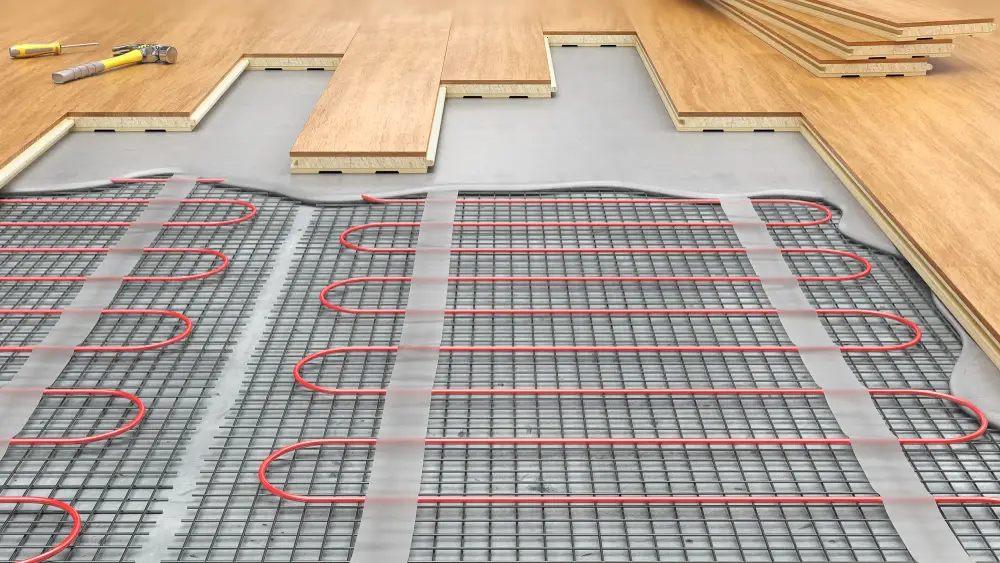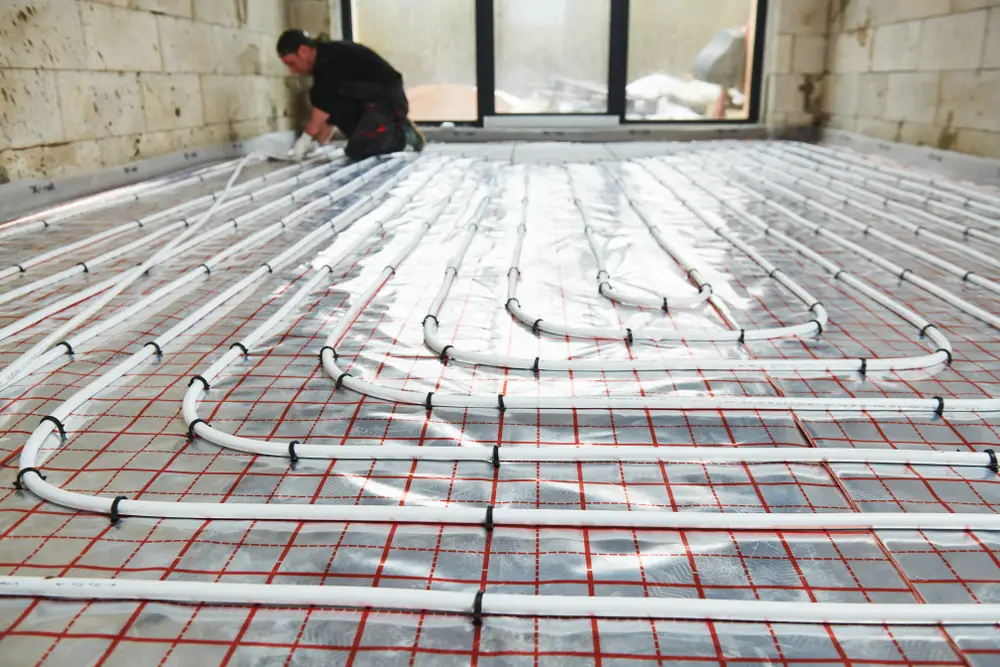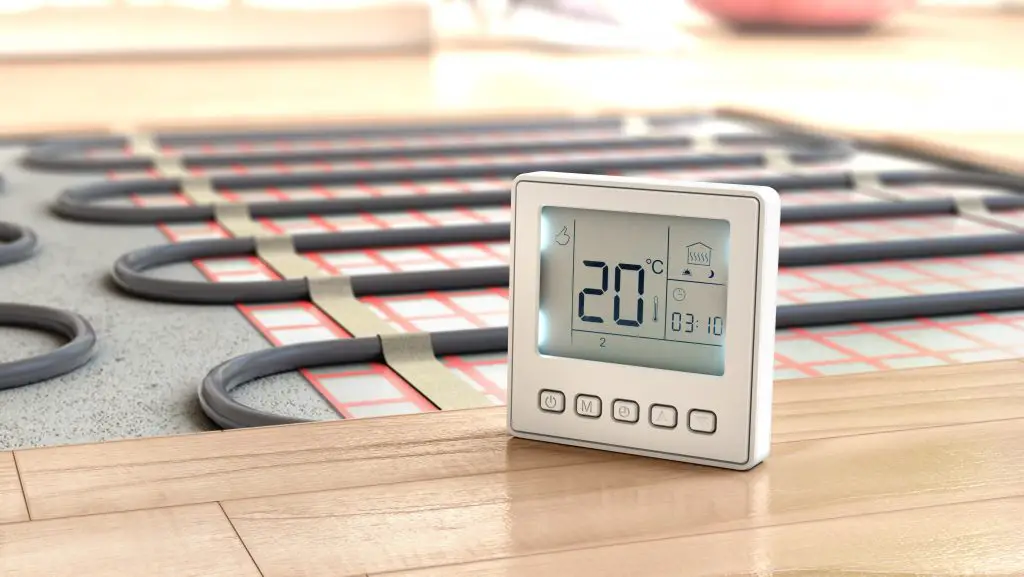Underfloor heating is an efficient heating system that provides radiant heat from beneath floors, but can this heat rise up and heat an entire home efficiently? Can underfloor heating heat an entire home on its own?
You can heat a whole house with either water or electric underfloor heating systems. The heat from either system will radiate upwards throughout the home. You need adequate insulation to prevent heat loss from the home and retain the heat from your underfloor heating.
The application of underfloor heating systems to heat entire homes and how they could be combined with other heating systems have been explained in great detail below.

Water Vs Electric Underfloor Heating – Where is each system used?
Electric Underfloor heating systems are used for smaller room spaces, such as kitchens, bathrooms, and bedrooms. Due to their flexibility, electric heating mats can be used to maneuver around kitchen sinks, cupboards, and bathtubs to prevent thermal blocking.
Electric underfloor heating is primarily used in homes that have already been built as it is easier to retrofit these into existing floors than to install a whole new water-based system with new pipes.

Water Underfloor heating systems are more commonly used in new buildings, since it is easier to incorporate them into the building plans, rather than having to reconstruct the floor just to fit it in. They are more suited to the ground floors of homes.

How much heat does underfloor heating produce?
On average, underfloor heating can reach temperatures of about 50°C, but due to the floor finishing, it could be limited to 27°C for vinyl, wood, carpet, and laminate floors. Tiles and concrete floors have a maximum temperature threshold of 29°C. Other factors such as room size and the level of floor insulation also play a huge role in how much heat is generated from the system.
There is a difference of course between the temperature of the water in underfloor heating pipes (or the electric heating mat wires) and the heat delivery to the rooms in the home. The thermal conductivity of the layers in the underfloor heating system, and of the floor finish must be considered, as must the length of time the system is running. As we mention below, the effectiveness of underfloor radiant heat is extremely dependent on the amount of insulation and subsequent heat loss from the home.
Is it enough for an entire home?
Room size heavily impacts the heat output from underfloor heating systems. The general idea is that the smaller the room, the quicker it will warm up (e.g. the bathroom).
Insulation and floor surface types are crucial for heat production. The main attribute of insulation is low thermal conductivity. It’s used in both wet (water) and electric heating, but insulation boards are a must-have for water underfloor heating. Insulation boards prevent the heat from spreading downwards and push as much heat as possible onto the surface layer.
Not only should you have insulation within the underfloor heating system’s layer structure itself, but you must adequately insulate the roof and walls of your home to prevent heat loss.
The type of surface floor impacts the heat more than you think. Denser materials, like tiles, terracotta, and stone, conduct heat better than wood or vinyl. Tiles and stone can be heated up to more than 29° C (84.2 F), while vinyl or wood can only go up to 27° C. Most carpets can’t be heated above 27° C (80.6 F), but there are some products(TOG less than 2) specifically made for underfloor heated surfaces.

Fast Heating vs Slow Heating
The act of heating a house is different from that of heating the air. Everything will get hotter if you heat it more slowly. If you heat the air quickly, the air will be warmed first, and the thermostat, which measures only air temperature, will register a higher reading. If you have, say, stone benches or walls, they will still feel cold.
Slow heating methods like underfloor heating will take much time to heat your house and not just its air. But after when they are turned off, the house would be able to retain heat for a longer time as floors and furniture get cooler much slower than the air itself. These systems have lower energy costs per hour of operation.
Heat is generated by electric underfloor heating almost as quickly as by radiators. In contrast, water underfloor heating reacts a bit more slowly. Similarly, water underfloor heating also takes some time to cool down.
Fast heating methods like central heating systems will quickly raise the room air temperature and you will feel hotter much more quickly. However, upon turning off them, the house will also cool down much quicker. These systems have also much higher energy costs per hour of operation.
How efficient is underfloor heating?
You’ll keep reading about underfloor heating being cost and energy-efficient, but is it true? Well, yes. The core aim of underfloor heating is to warm up your house, with the same amount or less energy, than radiators or any other older heating systems would otherwise need.
Water-based underfloor heating heats the water through the pipes to a temperature of 40° C. The temperature can be set even lower than that(35° C) if you want to keep the heating on for a longer time. Radiators, for example, are often heated to higher temperatures such as 60 degrees to radiate their heat from the point in the room where they are situated.
Underfloor heating disperses heat evenly on the floor surface, while radiators emit heat from only one point. One part of the room can be too hot, while another can be chilly at the same time. As far as it goes for heat efficiency, underfloor heating wins this battle by a mile.
The myth that underfloor heating is expensive is false. Yes, the installation can be costly, but it will save you money in the long run. Using water underfloor heating for an entire house is also cheaper than using underfloor electric cables, mostly due to the tariff prices.
Can you put underfloor heating upstairs?
You can use underfloor heating on the upstairs floor by all means. It’s best to think ahead before installing the heating system, though. When building a new project, you can connect both ground-level and upstairs water underfloor heating to the same water and electricity sources. This will greatly reduce the cost of installation as opposed to installing separate systems on each floor.

Electric-based systems can easily be installed upstairs and are often used when renovating your house. You can install metal heat plates from above the joists, which adds only about 15 mm of floor level. Another variant is attaching the plates between the joists. Keep in mind that the warm-up time will increase because of the overall lower surface of the plates.
Water-based underfloor heating can be connected to a heat pump. Heat pumps are exceptional when using the same water heating system on multiple house floors. They’re 40% more efficient than radiators or boilers and are better at converting electricity into heat. Ground source heat pumps can use solar energy to heat water. This way, you can easily heat the entire house using one underfloor heating system.

Can you have underfloor heating downstairs and radiators upstairs?
The use of radiators would reduce the initial cost of the installation which might be good to hear, but the use of radiators with underfloor heating would reduce the overall efficiency of the system, especially when heat pumps are the heat source. The heat pump would struggle to match the temperature needed for both the radiator and the underfloor heating system efficiently.
Radiators often reduce the humidity level of a room. These pieces of metal need to heat up well to make your room cozy. Nonetheless, they’re great when you need to warm yourself quickly. Underfloor heating systems can take some time before you can feel the warmth, especially if they’re used on multiple floors simultaneously.
The good news is, radiators and underfloor water heating can be connected to the same boiler or heat pump. You’ll have to do some extra adjusting though because radiators run on around 60° C (140 F) and underfloor heating on 40° C (104 F) or less. It’s recommended to use programmable thermostats, one for radiators and the other for the underfloor system.

Conclusion
Underfloor heating can heat a whole house. The choice of the type of underfloor heating is now dependent on where it is to be deployed. Electric and Water underfloor heating can both be used, but each of them is more suited to a particular home setting. Electric underfloor is more suitable for already built homes, small-sized rooms, rooms with irregular shapes, and fixed furniture.
Water-based heating is more expensive to install, but it makes up for the cost in the long run. Electric system running costs depend on your tariff prices and are generally very easy to install. You can mix these systems on different floors of your house, or you can combine them with an already existing radiator heating. No matter the choice, your house will always stay warm.
Lots more Underfloor Heating Information Here
- What Depth is Required for Underfloor Heating?
- Turning on Underfloor Heating for the First Time – How Long to Wait?
- Can you lay Vinyl flooring over underfloor heating?
- Do Tiles Crack With Underfloor Heating?
- Can You Heat a Whole House With Underfloor Heating?
- Can You Have Underfloor Heating Upstairs?
- Will Underfloor Heating Raise My Floor? – Underfloor Heating Layers Explained
- Can I put furniture on top of underfloor heating?
- How Do I Know If My Underfloor Heating is Leaking?
- Can You Combine Underfloor Heating With a Ground Source Heat Pump?
- Is Underfloor Heating Safe?
- Does Underfloor Heating Add Value to a Property?
- Can you have Wooden Floors with Underfloor Heating?
- Can Underfloor Heating Cause a Fire?
- What temperature should Underfloor Heating be set at?
- Can I Put a Rug Over Underfloor Heating?
- How Long Does it Take for Underfloor Heating to Warm Up?
- Why is my Underfloor Heating Noisy?
- Why is my Underfloor Heating Patchy?
- How do I know if My Underfloor Heating is Working? – Common Problems & Fixes
- What can go wrong with underfloor heating?
- Can you Combine Underfloor Heating with an Air Source Heat Pump?
- Do you keep underfloor heating on all the time?
- Does Underfloor Heating work with Smart Thermostats?
- Kitchen Underfloor Heating – Should Underfloor Heating go Under Kitchen Units?
- How much energy does Underfloor Heating use?
- Underfloor Heating in Summer and Winter
- Lifespan of Underfloor Heating
